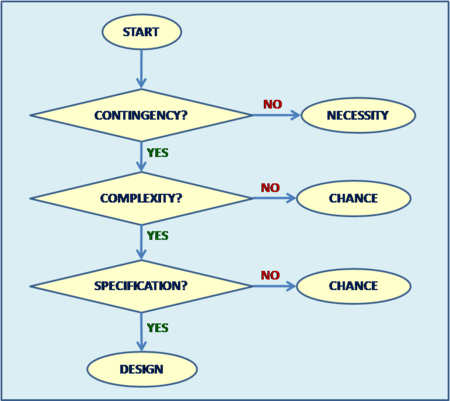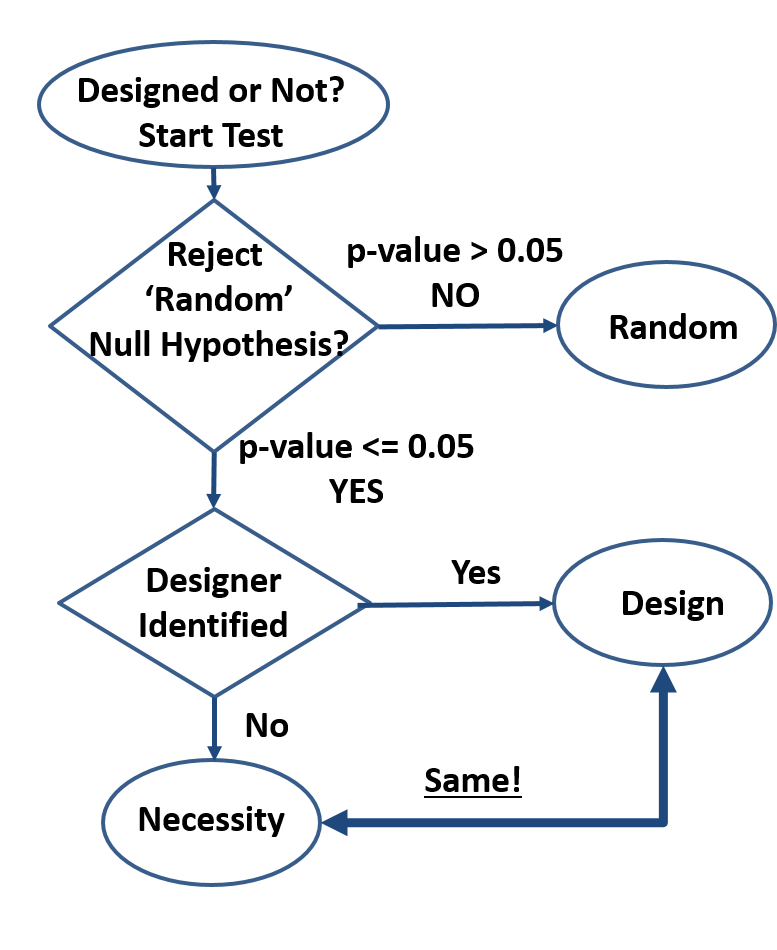- Design is order imposed on parts of a system. The system is designed even if the order created is minimal (e.g. smearing paint on cave walls) and even if it contains random subsystems. ‘Design’ is inferred only for those parts of the system that reveal the order imposed by the designer. For cave art, we can analyze the paint, the shape of the paint smear, the shape of the wall, composition of the wall, etc. Each one of these separate analyses may result in separate ‘designed’ or ‘not designed’ conclusions. The ‘design’-detection algorithm shown in the attached diagram can be employed to analyze any system desired.
- How do we know something is not random? By rejecting the null hypothesis: “the order we see is just an artifact of randomness”. This method is well established and common in many fields of research (first decision block in diagram). If we search for extraterrestrial life, archeological artefacts, geologic events, organic traces, etc., we infer presence based on specific nonrandom patterns. Typical threshold (p-value) is 0.05 meaning “if the outcome were due to randomness (null), it would only be observed in 5% or less of trials”. To reject the “randomness” hypothesis, the actual threshold is not critical, as probabilities get extreme quickly. For instance, given a 10 coin toss set, the probability of that set matching a predetermined sequence (this could be the first set sampled) given a fair coin is 0.1%, well below the 5% threshold. A quick glance at biological systems show extreme precision repeated over and over again and indicating essentially zero probability of system-level randomness. Kidneys and all other organs are not random, reproduction is not random, cell structure is not random, behavior is not random, etc.
- Is a nonrandom feature caused by design or by necessity? Once randomness has been excluded, the system analyzed must be either designed as in “created by an intelligent being”, or a product of necessity as in “dictated by the physical/scientific laws”. Currently (second decision block in diagram), a design inference is made when potential human/animal designers can be identified, and a ‘necessity’ inference is made in all other cases, even when there is no known necessity mechanism (no scientific laws responsible). This design detection method is circumstantial hence flawed, and may be improved only if a clearer distinction between design and necessity is possible. For instance, the DNA-to-Protein algorithm can be written into software that all would recognize as designed when presented under any other form than having been observed in a cell. But when revealed that this code has been discovered in a cell, dogmatic allegiances kick in and those so inclined start claiming that this code is not designed despite not being able to identify any alternative ‘necessity’ scenario.
- Design is just a set of ‘laws’, making the design-vs-necessity distinction impossible. Any design is defined by a set of rules (‘laws’) that the creator imposes on the creation. This is true for termite mounds, beaver dams, beehives, and human-anything from pencils to operating systems. Product specifications describe the rules the product must follow to be acceptable to customers, software is a set of behavior rules obeyed, and art is the sum of rules by which we can identify the artist, or at least the master’s style. When we reverse-engineer a product, we try to determine its rules – the same way we reverse-engineer nature to understand the scientific laws. And when new observations infirm the old product laws, we re-write them the same way we re-write the scientific laws when appropriate (e.g. Newton’s laws scope change). Design rules have the same exact properties as scientific laws with the arbitrary distinction that they are expected to be limited in space and time, whereas scientific laws are expected to be universal. For instance, to the laboratory animals, the human designed rules of the laboratory are no different than the scientific laws they experience. Being confined to their environment, they cannot verify the universality of the scientific laws, and neither can we since we are also confined in space and time for the foreseeable future.
- Necessity is Design to the best of our knowledge. We have seen how design creates necessity (a set of ‘laws’). We have never confirmed necessity without a designer. We have seen that the design-necessity distinction is currently arbitrarily based on the identification of a designer of a particular design and on the expectation of universality of the scientific laws (necessity). Finally, we can see that natural designs cannot be explained by the sum of the scientific laws these designs obey. This is true for cosmology (galaxies/stars/planets), to geology (sand dunes/mountains/continents), weather (clouds/climate/hydrology), biology (molecules/cells/tissues/organisms), and any other natural design out there.
- Scientific laws are unknowable. Only instances of these laws are known with any certainty. Mathematics is necessary but insufficient to determine the laws of physics and furthermore the laws of chemistry, biology, behavior, etc., meaning each of the narrower scientific laws has to be backwards compatible with the broader laws but does not derive from the more general laws. Aside from mathematics that do not depend on observations of nature, the ‘eternal’ and ‘universal’ attributes attached to the scientific laws are justified only as simplifying working assumptions, yet too often these are incorrectly taken as indisputable truths. Any confirming observation of a scientific law is nothing more than another instance that reinforces our mental model. But we will never know the actual laws, no matter how many observations we make. Conversely, a single contrary observation is enough to invalidate (or at least shake up) our model as happened historically with many of the scientific laws hypothesized.
- “One Designer” hypothesis is much more parsimonious compared to a sum of disparate and many unknown laws, particles, and “random” events. Since the only confirmed source of regularity (aka rules or laws) in nature is intelligence, it takes a much greater leap of faith to declare design a product of a zoo of laws, particles, and random events than of intelligence. Furthermore, since laws and particles are presumably ‘eternal’ and ‘universal’, randomness would be the only differentiator of designs. But “design by randomness” explanation is utterly inadequate especially in biology where randomness has not shown a capacity to generate design-like features in experiment after experiment. The non-random (how is it possible?) phantasm called “natural selection” fares no better as “natural selection” is not a necessity and in any case would not be a differentiator. Furthermore, complex machines such as the circulatory, digestive, etc. system in many organisms cannot be found in the nonliving with one exception: those designed by humans. So-called “convergent evolution”, the design similarity of supposedly unrelated organisms also confirms the ‘common design’ hypothesis.
- How does this proposed Intelligent Design Detection Method improve Dembski’s Explanatory Filter?
 The proposed filter is simpler, uncontroversial with the likely [important] exception of equating necessity with design, and is not dependent on vague concepts like “complexity”, “specification”, and “contingency”. Attempts to quantify “specified complexity” by estimating ”functional information” help clarify Dembski’s Explanatory Filter, but still fall short because design needs not implement a function (e.g. art) while ‘the function’ is arbitrary as are the ‘target space’, ‘search space’, and ‘threshold’. Furthermore, ID opponents can easily counter the functional information argument with the claim that the ‘functional islands’ are linked by yet unknown, uncreated, eternal and universal scientific laws so that “evolution” jumps from island to island effectively reducing the search space from a ‘vast ocean’ to a manageable size.
The proposed filter is simpler, uncontroversial with the likely [important] exception of equating necessity with design, and is not dependent on vague concepts like “complexity”, “specification”, and “contingency”. Attempts to quantify “specified complexity” by estimating ”functional information” help clarify Dembski’s Explanatory Filter, but still fall short because design needs not implement a function (e.g. art) while ‘the function’ is arbitrary as are the ‘target space’, ‘search space’, and ‘threshold’. Furthermore, ID opponents can easily counter the functional information argument with the claim that the ‘functional islands’ are linked by yet unknown, uncreated, eternal and universal scientific laws so that “evolution” jumps from island to island effectively reducing the search space from a ‘vast ocean’ to a manageable size.
- Summary
- Design is order imposed on parts of a system
- A system is nonrandom if we reject the null hypothesis: “the order we see is just an artifact of randomness”
- Current design detection method based on identifying the designer is circumstantial hence flawed
- Design is just a set of ‘laws’, making the design-vs-necessity distinction impossible
- Necessity is Design to the best of our knowledge
- Scientific laws are unknowable. Only instances of these laws are known with any certainty
- “One Designer” hypothesis is much more parsimonious compared to a sum of disparate and many unknown laws, particles, and “random” events
- This Intelligent Design Detection Method improves on Dembski’s Explanatory Filter
- Pro-Con Notes
- Con: Everything is explained by the Big Bang singularity, therefore we don’t need Intelligent Design.
- Pro: How can a point of disruption where all our knowledge completely breaks down explain anything? To the best of our knowledge, Intelligent Design is responsible for that singularity and more.
Links:
- https://fr-s-schneider.ncifcrf.gov/paper/ev/dembski/specified.complexity.html
- https://en.wikipedia.org/wiki/List_of_scientific_laws_named_after_people
- https://en.wikipedia.org/wiki/List_of_eponymous_laws
- http://molbio.mgh.harvard.edu/szostakweb/publications/Szostak_pdfs/Szostak_2003.pdf
- http://theskepticalzone.com/wp/does-gpuccios-argument-that-500-bits-of-functional-information-implies-design-work/
- https://uncommondescent.com/intelligent-design/functional-information-defined/ -gpuccio ID https://babel.hathitrust.org/cgi/pt?id=mdp.39015005472033;view=1up;seq=9 – W Paley
- https://plato.stanford.edu/entries/teleological-arguments/
- https://en.wikipedia.org/wiki/Teleology_in_biology
- https://www.random.org/analysis/
- http://www.metanexus.net/essay/how-not-detect-design-review-william-dembskis-design-inference
- https://biologos.org/blogs/archive/why-dembskis-design-inference-doesnt-work-part-1
- https://en.wikipedia.org/wiki/The_Design_Inference
- http://creationwiki.org/Explanatory_Filter
